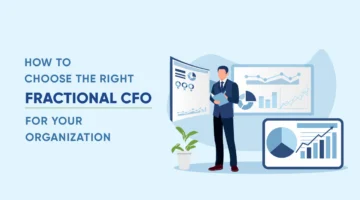CFO Profit Strategies: Why Every CFO Has a Midas Touch for Profit
The role of the CFO in modern businesses has evolved far beyond traditional financial management. They are strategic leaders who leverage advanced technologies, data analytics, and CFO Profit Strategies to drive business growth and long-term success.
How CFOs Turn Financial Data into Profit
CFOs are crucial in transforming financial data into actionable insights that drive profitability. Their unique ability to analyze complex financial information and implement strategies that enhance the bottom line gives them the proverbial “Midas touch.”
Data-Driven Decision Making
At the core of every successful CFO profit strategy is data-driven decision-making. CFOs use financial data to make informed decisions aligning with the company’s strategic goals. This involves analyzing revenue streams, cost structures, and market trends to pinpoint areas where profit margins can be increased.
- Example: A CFO analyzes customer purchasing patterns to adjust pricing strategies or assess the cost-effectiveness of supply chains to reduce expenses. This approach not only helps identify the most profitable segments but also minimizes inefficiencies that can erode profit margins.
- Stat Insight: According to a report, companies that use data-driven strategies are 23 times more likely to acquire customers and 19 times more likely to be profitable than their peers.
Leveraging Financial Analytics
Full-time or fractional CFOs rely heavily on financial analytics to forecast future performance and identify potential risks. Advanced financial models allow them to simulate various scenarios, helping businesses prepare for market conditions.
- Predictive Analytics: CFOs use predictive analytics to forecast sales, costs, and cash flow, enabling them to make adjustments before issues arise.
- Benchmarking: By comparing the company’s financial performance against industry standards, CFOs can identify areas for improvement and implement strategies to stay competitive.
Optimizing Resource Allocation
Effective resource allocation is another critical aspect of an outsourced CFO’s profit strategy. CFOs ensure that capital is invested in areas that yield the highest returns. This involves reallocating funds from underperforming sectors to those with higher growth potential.
Proven CFO Profit Strategies to Boost the Bottom Line
CFOs are not just gatekeepers of financial data; they are strategic leaders who drive profitability through well-crafted, data-informed decisions. To boost the bottom line, CFOs employ various proven strategies that optimize costs, enhance revenue streams, and ensure long-term financial stability.
Leveraging Technology and Automation
One of the most effective CFO profit strategies is implementing technology and automation. By automating routine financial processes, such as accounts payable, invoicing, and financial reporting, CFOs can significantly reduce overhead costs and increase efficiency.
Key Benefits
- Reduced Errors: Automation minimizes human error, which can lead to more accurate financial data and fewer costly mistakes.
- Increased Speed: Automated systems process transactions and generate reports much faster than manual methods, enabling quicker decision-making.
Enhancing Revenue Streams
CFOs also focus on enhancing revenue streams as a core strategy for boosting profitability. This involves exploring new markets, adjusting pricing strategies, and optimizing product or service offerings to more effectively meet customer demand.
Approach
- Market Expansion: Entering new geographic markets or targeting new customer segments can drive additional revenue. CFOs analyze market data to identify the most profitable opportunities.
- Pricing Optimization: By evaluating price elasticity, CFOs can adjust pricing models to maximize revenue without losing customers.
Debt Management and Capital Structure Optimization
Effective debt management and capital structure optimization are also critical strategies CFOs employ. By managing the company’s debt levels and optimizing the mix of debt and equity, CFOs can reduce interest expenses and improve the company’s financial health.
Key Tactics
- Debt Refinancing: CFOs may refinance existing debt to take advantage of lower interest rates, thereby reducing the cost of capital.
- Capital Allocation: CFOs optimize the company’s capital structure by balancing equity and debt, ensuring the company is not over-leveraged while maximizing ROI.
Implementing Performance Metrics and KPIs
CFOs are also instrumental in continuously implementing KPIs and other metrics to monitor financial performance. These tools allow CFOs to track profitability drivers and make data-driven decisions that align with the company’s strategic goals.
Examples of KPIs
- Gross Profit Margin: Measures the efficiency of production processes and pricing strategies.
- Return on Assets (ROA): Indicates how effectively a company uses its assets to generate profit.
- Result: Companies that regularly track and optimize their KPIs are 33% more likely to achieve their financial goals, according to a study by the Harvard Business Review.
The Future of CFO Profit Strategies
As the business landscape continues to evolve, so do CFOs’ strategies to drive profitability. Emerging trends in technology, data analytics, and economic shifts will shape the future of CFO profit strategies. By staying ahead of these trends, CFOs can position their companies to survive and thrive in an increasingly competitive market.
Embracing Emerging Technologies
CFOs must embrace new technologies like AI and ML to enhance decision-making processes and uncover hidden profit opportunities. These technologies can analyze vast amounts of data far more quickly and accurately than traditional methods, enabling CFOs to make more informed strategic decisions.
- AI in Financial Planning: AI can predict financial outcomes based on historical data, helping CFOs to forecast revenue more accurately and optimize budgets accordingly. For instance, AI-driven predictive analytics can identify patterns in customer behavior that may signal new revenue streams.
Leveraging Big Data for Strategic Decisions
The ability to leverage big data is becoming increasingly crucial for CFOs. By analyzing large datasets, CFOs can gain insights into market trends, customer preferences, and operational efficiencies, all of which can be translated into profit-enhancing strategies.
Key Applications
- Market Trend Analysis: CFOs can use big data to track and predict market trends, enabling them to adjust strategies in real-time and stay ahead of the competition.
- Customer Segmentation: By analyzing customer data, CFOs can identify high-value customer segments and tailor products or services to meet their specific needs, driving higher profit margins.
Navigating Economic Uncertainty
The global economy is increasingly unpredictable, with factors like trade tensions, political instability, and pandemics impacting markets in unforeseen ways. To protect profitability, CFOs must develop strategies that are resilient in the face of economic uncertainty.
Resilience Strategies
- Diversification: CFOs should advocate diversifying the company’s investment portfolio to spread risk across different sectors or geographic regions.
- Scenario Planning: Engaging in scenario planning allows CFOs to prepare for multiple economic outcomes, ensuring the company can adapt quickly to changing conditions.
The Role of Sustainability in Profit Strategies
Sustainability is becoming an integral part of long-term profit strategies. Consumers and investors increasingly favor companies prioritizing environmental and social governance (ESG). CFOs integrating sustainability into their financial strategy can enhance brand reputation, attract investment, and drive profitability.
Sustainability Initiatives
- Energy Efficiency Projects: Investing in energy-efficient technologies can reduce operational costs and appeal to environmentally-conscious customers.
- Sustainable Supply Chains: By ensuring that suppliers adhere to sustainable practices, companies can reduce risks and costs associated with environmental compliance.
As the financial landscape evolves, CFOs must adapt by embracing new technologies. These approaches drive immediate financial gains and position companies for long-term success in an increasingly competitive market.
If your business wants to unlock new profit opportunities and secure its economic future, now is the time to act. Contact us today to learn how our fractional CFOs help in implementing cutting-edge profit strategies tailored to your business needs.
Get Your Free Consultation
Gain Financial Visibility Into Your Business
We provide outsourced CFO, fractional CFO, and temporary CFO, Internal controller services, and operational Accounting services that suit the needs of your business.
- Hourly Rates
- No Hidden Fees
- No Long Term Requirements
NOW CFO provides the highest level of expertise in finance and operational accounting to accelerate results and achieve strategic objectives for sustainable growth and success.
After completing the form, a NOW CFO Account Executive will reach out and learn more about your needs so that we can pair you with the right Partner
Learn More: Why Your Business Deserves Better Accounting



